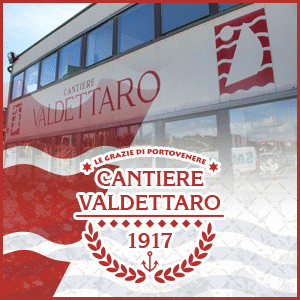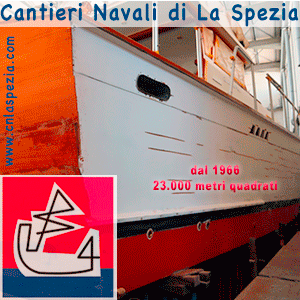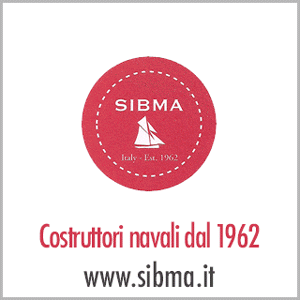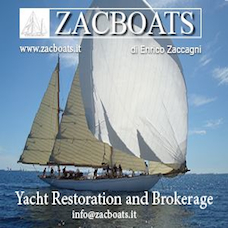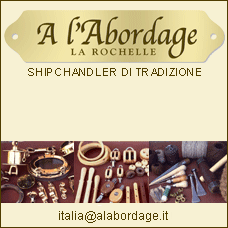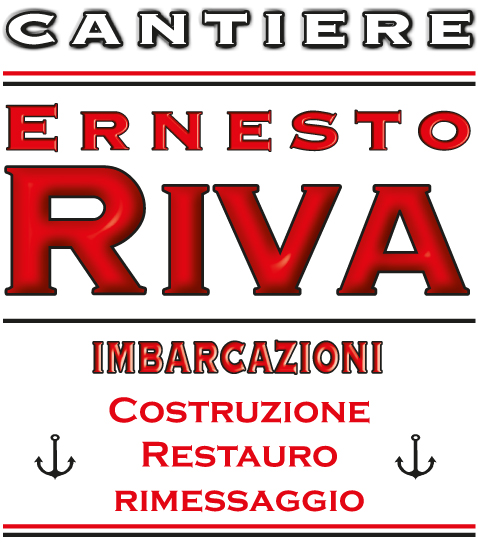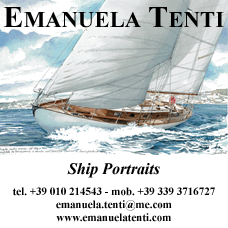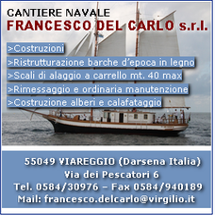
ITALIAN/ENGLISH TEXT
Di Paolo Maccione - Aprile 2021
Fotografie di Paolo Maccione
Chi è Alberto M. Villa?
Sono uno dei tanti milanesi, classe 1961, che nonostante la lontananza dal mare ha sempre navigato su scafi a vela e a motore, anche in acque in interne, soprattutto sul Lago di Como, dove nel 1973 la mia famiglia ha costruito una casa che abbiamo frequentato e amato per oltre trent’anni. Nella vita professionale, dopo la laurea in Economia e i primi anni di lavoro in una società americana di consulenza, ho operato a livello imprenditoriale nel settore agroalimentare, dell’energia e immobiliare, mia principale occupazione attuale. Dal 1990 sono socio ASDEC, Associazione Scafi d’Epoca e Classici, storico sodalizio fondato nel 1987 all’interno del quale ricopro la carica di Consigliere.
SALI A BORDO! CLICCA SUL VIRTUAL TOUR DEL RIVA CARIBE "UFO"
Sappiamo che è sempre stato legato al Museo della Barca Lariana di Pianello Lario.
Sì, conosco e frequento il Museo da tanti anni, avendo avuto la fortuna di incontrare e stringere amicizia con il suo fondatore, il milanese GianAlberto Zanoletti, scomparso nel 2019 all’età di 76 anni. Ho pertanto affiancato GianAlberto e successivamente suo figlio Ferdinando nello sviluppo e valorizzazione del Museo, frutto di anni di incredibile e lungimirante opera di raccolta da parte della Famiglia Zanoletti, fino alla attuale creazione della Fondazione, di cui sono Vice Presidente, e alla conseguente riapertura al pubblico avvenuta a luglio 2018. Il Museo, posto all’interno di un’antica filanda dell’800, ha raccolto e salvato dalla distruzione oltre 400 barche, ed è tutt’ora in fase di sviluppo, con la prossima creazione di nuovi spazi espositivi e ricettivi. E’ probabilmente, nel suo genere, la più importante raccolta al mondo.
Facciamo un passo indietro. Come è nata la passione per la nautica tradizionale?
Ho iniziato a navigare da ragazzo sul Lago di Como: una passione innata, generata presso il Cantiere Colombo di Menaggio, di cui mio padre è stato per alcuni anni consulente amministrativo, e dove ammiravo magnifici scafi Riva e Colombo. Lì mio padre acquistò un Riva Bertram, sul quale ebbi un battesimo piuttosto traumatico: poco distante dalla riva di Cadenabbia, un tardo pomeriggio del mese di agosto del 1973, per motivi sconosciuti, il motore scoppiò e la barca andò a fuoco, costringendoci a salvarci guadagnando la riva a nuoto! Non dissuaso dall’attrazione della navigazione sul lago, ripresi a navigare su una splendida Lucia in legno del Maestro d’Ascia Mario Leoni di Lenno, e successivamente su una Pilotina in vetroresina del Cantiere Tripesce, per poi passare alla vela, su una Star di Lillia, quindi su un 5.50 SI in legno (restaurato in due fasi presso il Cantiere Leopoldo Colombo), e infine su Dulcinea, magnifica Lancia Inglesina in legno del 1920 fatta costruire da mio Bisnonno Isaia Volontè dal Cantiere Taroni, restaurata in due fasi dal Cantiere Leopoldo Colombo e dal Cantiere Matteri e recentemente donata al Museo Barca Lariana. Lasciato il Lago, e acquistato una casa con mia moglie nella pineta di Arenzano, ho acquistato nel 2012 un Bertram 31 Sport Fisherman del 1973, che ho fatto restaurare a Genova dal Cantiere Genoa Sea Service, e col quale ho partecipato ad alcuni raduni di American Classic Yachts e ho fatto alcune crociere nel Mar Ligure, in Francia e nel Mar Tirreno. Ultimamente ho restaurato un Taxi Veneziano, oggi gestito da Como Classic Boats, e l’ultimo esemplare prodotto del Comitti Alassio in legno.
Cose ne pensa delle barche in legno?
Nonostante lo sviluppo della nautica moderna e di materiali alternativi, come la vetroresina o i cosiddetti compositi, il legno non è mai scomparso. Basti solo pensare che ancora oggi gli interni delle imbarcazioni sono quasi interamente realizzati con il più nobile dei materiali. Le barche in legno, e anche le tecniche per realizzarle, non scompariranno mai. Sono parte integrante della storia dell’uomo, anche se purtroppo ogni anno vecchi scafi vengono demoliti per l’impossibilità di poterli recuperare.
Però un bel giorno vi siete fatto tentare dalla vetroresina …
Sì. UFO è stata la mia quarta barca in vetroresina. Si tratta di un motoryacht modello Riva Caribe 42 del 198o, lungo 12 metri, acquistato ad Olbia in seguito ad un annuncio privato. Lo si potrebbe definire uno sport cruiser con il flybridge, un motoryacht aperto senza paratie divisorie in pozzetto e con un open-space sottocoperta. È uno scafo in grado di garantire crociere sicure in mare aperto, con prestazioni tutt’oggi più che apprezzabili, in grado di navigare fra i 18 e i 26 nodi di crociera, e di superare agevolmente i 30 nodi di massima. In totale sono stati 24 i Riva Caribe prodotti, e UFO è il numero uno. Quasi tutti sono dislocati in Mediterraneo.
Dove ha navigato?
In quasi quarant’anni di vita la barca è sempre appartenuta ad un unico proprietario, ha mantenuto lo stesso nome ed è sempre stata gestita da uno stesso marinaio, anche meccanico-motorista, che ho avuto il piacere di conoscere e apprezzare in occasione dell’acquisto. Ha navigato quasi esclusivamente in Sardegna, in particolare lungo la costa nord orientale.
Dove è stato effettuato il restauro?
Presso la Nautica Casarola di Peschiera del Garda, attiva dal 1964 e una delle realtà più storiche e importanti d’Italia specializzata nel settore della motonautica. Basti pensare che il suo Presidente, Cesare Casarola, da oltre 50 anni continua ad essere uno dei più importanti dealer del mondo nel settore delle imbarcazioni Riva. Il restauro di UFO, in particolare, è stato seguito passo dopo passo da Edoardo Casarola, figlio di Cesare.
Quanto è durato il restauro?
Circa 6 mesi, da febbraio a luglio 2019. Poi la barca è stata trasferita a La Spezia e da qui ha raggiunto via mare la Sardegna. Oggi fa base in Liguria.
Quale filosofia progettuale ha animato il restauro?

Si è trattato di un restauro integrale, con il preciso obiettivo di riportare la barca allo stato di origine, intervenendo nel contempo per verificare e consolidare la struttura. Non si è trattato pertanto di un semplice lavoro di ordinaria manutenzione. La barca è stata svuotata e smontata totalmente e si è intervenuti su tutto: scafo, impiantistica, motorizzazione, serbatoi, interni. Smontati anche tutti gli oblò, i pannelli della strumentazione, l’accessoristica; aperti, controllati e aggiornati tutti i quadri e i cablaggi elettrici. E poi è stato rimontato tutto, nell’assoluto rispetto di colori, forme e materiali originali. Ripristinare l’imbarcazione come in origine ci ha consentito di farla tornare a navigare in perfette condizioni almeno per un altro ventennio. In futuro si interverrà solo per ordinarie e periodiche manutenzioni.
Può descrivere alcuni degli interventi compiuti? 
Tra i primi interventi la ricostruzione quasi integrale, della struttura portante del fly. Ricostruito quasi integralmente il nuovo specchio di poppa, cui è stata appoggiata una nuova plancetta in metallo e teak a carabottino, di disegno uguale a quello originale ma di maggiore profondità rispetto alla precedente, unica variante rispetto all’originale ma più in linea con le moderne esigenze di vivibilità. Restaurate anche le panche originali del pozzetto e del piano prendisole poppiero, realizzato in compensato marino a sandwich di abete e nido d’ape. Smontate e ricostruite con materiali e colori originali tutte le cuscinerie della zona della timoneria, della dinette coperta, delle sedute e prendisole di poppa e del fly.
E per quanto riguarda lo scafo e la coperta?
Verificato accuratamente lo stato di tutto lo scafo da esperti conoscitori della linea di produzione dei Riva Bravo e Caribe, e misurati con appositi strumenti tutti gli spessori, è stata accertata una buona condizione generale dell’opera viva, ma con spessori medi minori degli standard di fine produzione (3.900 g/mq anziché 4.950 g/mq), derivante m)mq)derivante dal fatto che si tratta del primo esemplare prodotto; per maggior sicurezza, anziché intervenire aumentando gli spessori, si è quindi optato per inserire due strutture trasversali aggiuntive all’interno dello scafo in resina ortoftalica, rinforzando nel contempo i pattini longitudinali dall’esterno mediante resina vinilestere. In questo modo si è ottenuta la massima robustezza senza inutili aggravi di peso. Le imperfezioni della vetroresina sono state evidenziate tramite la posa di una speciale polvere di colore arancione, in grado di rilevare spaccature e fessurazioni. Ai lati dei prendisole è stato asportato il vecchio gelcoat screpolato ed eseguita una nuova laminatura in vetroresina, seguita dalla posa del nuovo gelcoat, poi carteggiato e spianato in vista della verniciatura. Su tutte le parti chiare, in esterni, coperta e fly, sono state posate 2-3 mani di base opaca, seguita da 3 mani di trasparente bicomponente, premessa alla carteggiatura e lucidatura.
Gli interni?

Sottocoperta si è proceduto alla riverniciatura delle parti lucide, preceduta dalle operazioni di carteggiatura, stuccatura e dalla posa di un fondo bicomponente. Tre le mani di vernice bicomponente applicate, marca Lechler di colore blu navy, perfettamente corrispondente all’originale. Sempre in interni si è proceduto allo smaltimento delle vecchie tappezzerie del cielo della dinette e alla carteggiatura per eliminare i residui delle vecchie colle in preparazione dell’applicazione della nuova tappezzeria. È stato smontato l’arredo in compensato marino della cucina e si è proceduto alla riverniciatura come da originale di tutte le ante, in colore blu navy. Installati nuovi cielini in stoffa nella cabina prodiera e nel quadrato, un nuovo motore del wc elettrico, il boiler dell’acqua calda e la vasca per le acque bianche della doccia, della capacità di circa 15 litri. Anche tutte le pareti e il mobile del bagno sono stati riverniciati come da originale, in colore blu navy.
Altri interventi minori?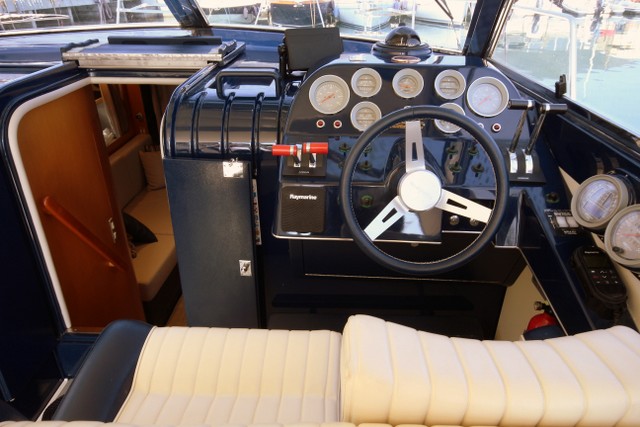
La posa di nuovi tappetini antisdrucciolo sui bordi esterni del pozzetto di poppa e lungo i due passavanti laterali, la sostituzione della struttura centrale del cruscotto del flybridge, la revisione del generatore, la sabbiatura dei tientibene, la revisione del pistone della timoneria idraulica, lo smontaggio e la pulizia con l’acido dei pistoni dei flap perché bloccati dal calcare, il ricondizionamento dei tubi e delle raccorderie, la ricostruzione del parabrezza superiore in forma e tinta originali. La sostituzione di alcune luci di cabina, dei tergicristalli, di targhette e cappucci, delle guarnizioni degli oblò, degli sfiati per i serbatoi, degli scarichi delle pompe di sentina, dell’aspirazione del gruppo elettrogeno. Per quanto riguarda l’ancora si è scelto di installare un modello Ultramarine da 16 chilogrammi in acciaio, con 75 metri di catena di sezione 8 millimetri. Nuovo anche il salpancore, identico all’originale, il musone dell’ancora, alcune leve dell’acceleratore e dell’invertitore (altre sono state ripulite e dotate di nuovi pomoli in plastica identici agli originali), ricondizionati e rivestiti di nuovo i volanti originali Riva, aggiunti gli strumenti ecoscandaglio e contamiglia originali Riva, sostituite le cerniere, le pompe, i ricambi filtri gasolio, inserita una nuova piastra a induzione per la cucina. Ricostruito il meccanismo attraverso il quale si può bloccare e sbloccare il prendisole scorrevole del pozzetto, totalmente smontato, in parte ricondizionato e riverniciato come da originale.
E per quanto riguarda la motorizzazione e l’impiantistica?

UFO monta due propulsori Cummins da 374 hp l’uno, mod. NS6 BTA, che avevano sostituito nel 2006 i precedenti Cummins da 320 hp l’uno originali del 1980, e che al momento dell’acquisto di UFO avevano totalizzato meno di 300 ore di moto; i motori sono stati sbarcati e completamente revisionati e certificati a ore zero dalla Cummins di Portogruaro, in provincia di Venezia. Il vantaggio di questi due propulsori, che hanno permesso di mantenere tutta l’impiantistica e la strumentazione originale marchiata Riva (a sua volta completamente revisionata), è rappresentato da un rapporto peso / potenza nettamente favorevole, oltre che da una meccanica molto più aggiornata. Prima della loro re-installazione si è proceduto alla verniciatura integrale del vano motore e di tutto il pagliolato interno originale, e alla posa delle nuove pannellature antirombo per l’insonorizzazione. I serbatoi del gasolio sono quelli originali Riva datati 1979, entrambi da 450 litri l’uno. Sbarcati e completamente lavati, in alcuni punti si è proceduto alla loro riparazione tramite saldature. Poi sono stati riverniciati con vernice a base di resina epossidica trasparente specifica per metalli. Identico trattamento è stato adottato sui serbatoi dell’acqua da 180 litri l’uno. Per quanto riguarda l’impiantistica è stato recuperato circa il 40% del totale dell’impianto elettrico, il 20% dell’impianto elettrico motore e il 70% dell’impianto elettrico del cruscotto; è stato mantenuto e restaurato il quadro elettrico generale.
Dopo il varo quali sono state le prestazioni di UFO in termini di velocità e marinità?
La prima prova in acqua è stata compiuta in data 17 luglio 2019, con partenza dalla sede di Lazise della Nautica Casarola, sul Lago di Garda. UFO ha raggiunto circa 32 nodi di velocità a 2900 giri, dimostrandosi leggera, silenziosa e maneggevole sull’acqua, con risposte immediate ai comandi, senza vibrazioni o fumosità. A 2000 giri ha navigato a 16 nodi (crociera economica), a 2300 giri ha navigato a circa 20 nodi e a 2600 giri a 27 nodi (crociera veloce). Nella prima uscita in mare, abbiamo affrontato il trasferimento in giornata da Bocca di Magra ad Olbia, con le prime quattro ore di navigazione con vento contrario e un’onda di prua di un metro e mezzo affrontata senza problemi a 15 / 16 nodi di velocità: governando dalla postazione interna, UFO ha sempre trasmesso sensazioni di grande solidità, con elevati margini di potenza e sicurezza.
E per quanto riguarda l’autonomia di navigazione?
Stimo circa 200 miglia a 22 nodi di crociera.
Possiamo fornire dei riferimenti economici?
Sicuramente posso affermare che tra l’acquisto dell’usato e i costi sostenuti per il restauro è stato speso circa il 60% rispetto all’acquisto di una barca nuova con queste caratteristiche e di pari lunghezza. E con il vantaggio che il suo valore nel tempo, a restauro terminato e in virtù della rarità, potrà ulteriormente rivalutarsi. Il tutto grazie alle sue linee e all’attualità del suo progetto, che la rendono perfettamente godibile e allineata alle esigenze del diportista moderno.
Cosa pensate abbia rappresentato questo restauro?
Innanzitutto un esempio di come sia possibile recuperare imbarcazioni in vetroresina di 40 anni di età, assicurandone la navigabilità e godibilità per almeno un altro ventennio. Oggi UFO si presenta in perfetto stato, sia per quanto riguarda lo scafo, l’attrezzatura di bordo, l’impiantistica e la motorizzazione. Ma soprattutto è stata salvata una barca entrata di diritto a fare parte della storia della nautica da diporto, grazie alla mano del suo progettista (Giorgio Barilani) e alla maestria del cantiere costruttore (Riva).
Però non è una “Barca d’Epoca” … 
No, è una Barca Classica. In ASDEC si è discusso molto su questo tema negli ultimi due anni. Ci si è resi conto che oltre al mondo delle Barche d’Epoca, imbarcazioni in materiali tradizionali (legno, acciaio, alluminio) con oltre venticinque di età, esiste un “altro mondo”, quello delle barche in materiali sintetici, che, con altrettanta anzianità, possono a tutti gli effetti essere oggetto di certificazione basata sostanzialmente sugli stessi parametri (manutenzione, originalità, restauro, navigabilità, patina d’uso, importanza storica), ma con la qualifica di Barca Classica e rilascio di apposita Targa di Bronzo. Possiamo quindi affermare che oggi si è voluto attribuire un meritorio riconoscimento nei confronti di quegli scafi in materiali sintetici che per il loro particolare interesse (linee, progettista, cantiere) possono essere definiti storici e dunque essere certificati come classici e iscritti nel Registro Storico Nautico di ASDEC. A tal fine i Consiglieri di ASDEC hanno avviato un lavoro di selezione e ricerca di cantieri e modelli che possono rientrare nel novero delle Barche Classiche secondo i requisiti definiti da ASDEC.
E’ un po’ come “vorrei, ma non posso … dunque mi accontento”?
Assolutamente no! È un modo differente di considerare uno scafo storico, qualunque esso sia. La storicità non è prerogativa di un determinato materiale di costruzione, in questo caso il legno o l’acciaio, ma può esserla anche di altri materiali, tra i quali la vetroresina. E ASDEC, sulla base della sua lunga esperienza, ha per prima individuato i criteri sulla base dei quali poter certificare la barche in vetroresina meritevoli di tutela con la qualifica di Barca Classica.
Quali vantaggi offre l’ASDEC agli associati armatori di barche come UFO?
L’entrare a far parte di una vera famiglia di appassionati, condividere occasioni di incontro e di scambio di esperienze e di cultura nautica, nonché acquisire quella sensibilità utile a valorizzare e gestire al meglio la propria imbarcazione e il proprio stile marinaresco.
Quali altre certificazioni ha ottenuto UFO?

Prima ancora che una Barca Classica secondo i parametri definiti da ASDEC, UFO è uno scafo RIVA: l’aver condotto un restauro filologico con il Cantiere Casarola, da sempre importante riferimento di RIVA in Italia, è stata una scelta dettata dal rispetto della marca e del prodotto, oltre che un’incredibile occasione per rivivere la cultura produttiva e il network di competenze dell’epoca, puntualmente testimoniate dall’immutata qualità dei materiali dell’imbarcazione a distanza di tanti anni. La qualità del restauro è stata quindi premiata dall’ottenimento della Targa Carlo Riva rilasciata da Riva Historical Society (www.rivahistorical.org), di cui sono socio.
Che cosa ha rappresentato per voi questo restauro? 
Il restauro di UFO può essere considerato un fantastico “laboratorio di sperimentazione” che possa contribuire ad avviare una nuova stagione di recupero di molti cruiser e open varati dai primi anni settanta fino ai primi anni novanta. Il non breve restauro mi ha permesso di condividere con Cesare ed Edoardo Casarola molte analisi sull’imbarcazione, sulle sue tecniche di costruzione, sui relativi materiali, sulle necessarie scelte di recupero nell’ottica della ricerca della massima originalità, pur considerando ove necessario alcuni aggiornamenti tecnici e funzionali. E’ stato quindi emozionante veder via via rinascere l’imbarcazione con i suoi splendidi colori, la ripristinata qualità delle sue attrezzature e il pieno recupero delle sue straordinarie linee che uniscono l’eleganza e il dinamismo di uno scafo potente, sicuro e veloce ancora oggi. Ed è per me ogni volta emozionante viverla in ogni momento in cui prendo il mare, in occasione di uscite giornaliere o di crociere anche di lungo raggio.
INFORMAZIONI
www.asdec.it
GALLERY
ENGLISH TEXT
Alberto M. Villa: Me and UFO,
my Riva Caribe, a great fibreglass classic
Interview with the Milanese Alberto M. Villa, member of the Board of Directors of ASDEC (Association of Classic and Vintage Boats) and Vice-President of the Museo Barca Lariana Foundation (Lake Como International Museum of Vintage Boats Foundation) in Pianello Lario, on Lake Como. He recently bought UFO, a 1980 Riva Caribe 42 motoryacht, completely restored by Nautica Casarola on Lake Garda. The results can serve as a yardstick for many boatowners who are planning to restore fibreglass boats of this kind. And will boats built from this material ever become “vintage”?
COME ON BOARD! CLICK THE VIRTUAL TOUR OF RIVA CARIBE "UFO"
Who is Alberto M. Villa?
I was born in Milan in 1961 and like many Milanese, despite the distance from the sea, I have always sailed sailboats and motorboats, on inland waters too, especially on Lake Como where in 1973 my family built a house and spent a lot of time. Workwise, after I graduated with a degree in Economics and spent my first years working for an American consultancy firm, I got involved as an entrepreneur in the agrofood sector, energy and real estate, which is currently my main line of work. Since 1990 I’ve been a member of ASDEC, the Italian Association of Classic and Vintage Boats, a historic organisation founded in 1987, currently holding the position of member of the Board of Directors.
We know that you have always had close ties with the Boat Museum Museo della Barca Lariana in Pianello Lario on Lake Como.
Yes, I have known and had dealings with the Museum for many years now, having had the chance to meet and become friends with its founder, the Milanese GianAlberto Zanoletti, who passed away in 2019 at 76 years of age. I actually worked with GianAlberto and subsequently with his son Ferdinando on the development and renovation of the Museum, the result of years of painstaking collection on the part of the Zanoletti family, until the creation of the Foundation of which I am now Vice-President, and the consequent re-opening to the public in July 2018. The Museum, located in an old nineteenth century textile mill, has collected and saved from destruction over 400 boats, and is still undergoing development work which will soon see the opening of new exhibition and reception spaces. It is probably the most significant collection of its kind anywhere in the world.
Let’s take a step backwards for a moment. Where did your great love for traditional sailing come from?
It was when I was a boy that I first began sailing on Lake Como. It was in my blood, beginning at the boatyard Cantiere Colombo in Menaggio where my father was an administrative consultant for some year, and where I got the chance to admire magnificent Riva and Colombo boats. It was there that my father bought a Riva Bertram, and on board this boat I had my baptism by fire: one late afternoon in August we were a short distance offshore from Cadenabbia when for unknown reasons the engine exploded and the boat caught fire, forcing us to swim to shore! But that didn’t put me off sailing on the lake and I went back on the water in a lovely wooden Lucia built by the boatwright Mario Leoni from Lenno, and later on a fibreglass Pilotina from the boatyard Cantiere Tripesce. I then moved on to sailboats, a Star from Lillia, then a wooden 5.50 SI (restored in two stages by the boatyard Cantiere Leopoldo Colombo), and finally on Dulcinea, a magnificent wooden Lancia Inglesina from 1920 commissioned by my great-grandfather Isaia Volontè from the boatyard Cantiere Taroni. This boat was restored in two stages by the boatyards Cantiere Leopoldo Colombo and Cantiere Matteri and recently donated to Museo Barca Lariana. When I left the Lake and bought a house in Arenzano with my wife, in 2012 I bought a 1973 Bertram 31 Sport Fisherman which I had restored in Genoa by the boatyard Genoa Sea Service. On this boat I took part in some meetings of American Classic Yachts and did some cruises in the Ligurian Sea, France and the Tyrrhenian Sea. Recently, I restored a Venetian Taxi, today managed by Como Classic Boats, and the last wooden boat produced by Comitti.
What do you think of wooden boats?
Notwithstanding developments in modern boatbuilding and alternative materials such as fibreglass or composites, wood has never gone away. Just think, the interiors of boats are still almost entirely made of this most noble of materials. Wooden boats, as well as the techniques for building them, will never disappear. They are an integral part of the history of mankind, even though every year old boats are demolished because it is no longer possible to restore them.
But there came a day when you succumbed to the allure of fibreglass …
Indeed I did. UFO was my fourth fibreglass boat. It is a 1980 Riva Caribe 42 motoryacht, 12 metres long, bought in Olbia through a classified ad. You may call it a sport cruiser with a flybridge, a motoryacht without partitions in the cockpit and an open-space below deck. It is a boat that can guarantee you safe cruising in the open sea and it has got a performance which is still excellent even by today’s standards, reaching a cruising speed of between 18 and 26 knots and easily topping a 32 knots maximum speed. A total of 24 Riva Caribe motoryachts were built, and UFO is the number one. Almost all of them are based in the Mediterranean.
Where has it been?
In almost forty years of life this boat only had one single owner, kept the same name and was handled by the same driver as well as mechanic-engineer, whom I had the pleasure to meet and get to know when I was buying the boat. It sailed almost exclusively in Sardinia, in particular along the north-eastern coastline.
Where was the restoration carried out?
At Nautica Casarola in Peschiera del Garda, which has been in the business since 1964 and is one of the major historic boatyards in Italy specialised in the motorboat sector. Suffice to say that the President, Cesare Casarola, has continued to be one of the main Riva dealers worldwide over the past 50 years. The restoration of UFO, in particular, was followed step by step by Edoardo Casarola, Cesare’s son.
How long did it take?
About 6 months, from February to July 2019. Then the boat was transferred to La Spezia and from there it went by sea to Sardinia. Today it is based in Liguria.
What was the philosophy behind the restoration?
It was a complete overhaul with the precise objective of restoring the boat to its original condition, at the same time checking and strengthening the structure. It was not just routine maintenance. The boat was emptied out and completely dismantled and everything was restored: the hull, systems, engine, tanks, interiors. Even the portholes were taken out, the instrument panels, the accessories; all the control panels and electrical wiring were opened up, checked and changed. And then everything was put back together again, in total compliance with the original colours, shapes and materials. Restoring the boat to its original condition meant that we were able to ensure that it would sail in perfect condition for at least another twenty years. In the future the only intervention needed will be for ordinary regular maintenance.
Can you describe some of the work that was carried out?
One of the first things jobs we undertook was the almost total reconstruction of the support structure for the flybridge. The same with the new transom which supports a new swim platform made of metal and teak, with the same design as the original but longer than the previous one, the only variation compared with the original one but more in keeping with modern liveability requirements. We also restored the original benches in the cockpit and the aft sundeck, made of marine plywood, a sandwich of fir and honeycomb. All the cushions in the steering house, covered dining area, seating area and aft and fly sundecks were taken out and remade with original materials and colours.
And what about the hull and deck?
A thorough inspection was carried out of the state of the hull by experts familiar with the Riva Bravo and Caribe production lines and special instruments were used to measure all the thicknesses, with the verdict that the boat was in good general condition, but the average thicknesses were lower than end production standards (3,900 g/m² instead of 4,950 g/m²), due to the fact that this was the first in the line ever produced: so for greater safety, instead of increasing thicknesses, we opted to insert two additional structures crossways inside the hull made of orthophalic polyester resin, at the same time reinforcing the hull from the outside using vinyl ester resin. This way we were able to get maximum strength without needlessly adding on extra weight. The imperfections in the fibreglass were detected by coating it with a special orange powder which showed up any splitting or cracks. We took off the old cracked gelcoat at the sides of the sundeck, sanded it down and planed it for painting. All the light parts, on the exterior, deck and fly, were given 2-3 coats of matt base coat, followed by 3 coats of a clear two component paint after first being sanded and polished.
What about the interiors?
Below decks we repainted all the gloss parts, after first sanding, filling in any cracks and giving a coat of two component primer. Three coats of two component paint were applied, Lechler brand, navy blue, perfectly matching the original. We also removed all the old upholstery from the ceiling of the dinette and sanded down surfaces in order to get rid of any residue of the old glues and prepare for the application of the new upholstery. The marine plywood kitchen units were taken out and all the doors restored to their original condition and navy blue colour, we fitted new fabric ceiling covers in the forward cabin and quarterdeck, a new motor in the electric toilet, hot water boiler and tank for the waste waster from the shower with a capacity of about 15 litres. All the walls and fittings in the bathroom were repainted in the original navy blue.
Any other minor jobs?
We fitted new non-slip mats on the edges of the aft cockpit and along the two gangways down the sides, replaced the central structure of the flybridge dashboard, overhauled the generator, sanded the handrail, overhauled the hydraulic wheelhouse piston, dismantled the pistons on the flaps and cleaned them with acid because they were clogged up with limescale, redid the pipes and pipe fittings, rebuilt the upper windscreen in the original shape and colours. We replaced some of the cabin lights, windscreen wipers, plaques and hoods, seals on the portholes, tank vents, bilge pump outlets, and genset extraction pumps. As regards the anchor, we opted for a 16 kilo steel Ultramarine with 75 metres of 8mm chain. We also fitted a new windlass, identical to the original, stemhead anchor roller, some accelerator and inverter levers (others were cleaned and fitted with new plastic knobs identical to the originals), we reconditioned and recovered the original Riva steering wheels, added an original Riva depth sounder and speedometer, replaced the hinges, pumps, diesel filters, and installed a new induction hob in the kitchen. We rebuilt the mechanism for locking and unlocking the sliding sundeck on the cockpit, dismantled it completely, partly reconditioned it, and repainted it in the original colour.
And what about the engines and systems?
UFO has two Cummins propulsion engines, 374 hp each, NS6 BTA models, which were fitted in 2006 and which, at the time of purchase of UFO had clocked up under 300 hours of sailing; the engines were taken off and completely overhauled and certified by the Cummins dealer in Portogruaro, near Venice. The advantage of these two propulsion engines, which allowed us to keep all the original Riva brand systems and instruments (also completely overhauled), is the excellent power to weight ratio as well as much improved mechanics. Before reinstalling them, we repainted the entire engine compartment and all the original interior flooring and put in new sound-deadening panels for soundproofing. The diesel tanks are the original Riva ones dated 1979 and hold 450 litres each. Taken out and washed out thoroughly, they required soldering repairs in some points. They were then repainted with a transparent epoxy resin paint specially designed for metals. The water tanks which hold 180 litres each got the same treatment. As far as the systems are concerned, we were able to keep about 40% of the overall electrical system, 20% of the engine electrical system and 70% of the dash panel electrical system; the general switchboard was kept and restored.
After the launch what kind of performance did UFO have in terms of speed and seafaring qualities?
The first test in water was carried out on 17th July 2019, leaving from the Nautica Casarola boatyard in Lazise on Lake Garda. UFO reached a speed of 32 knots at 2900 rpm, and was light, silent and easy to handle on the water, with immediate response to controls, without any vibration or fuel venting. At 2000 rpm it went at 16 knots (economy cruise), at 2300 rpm 20 knots and at 2600 rpm 27 knots (fast cruise). On our first outing on the sea, we undertook the day crossing from Bocca di Magra to Olbia with the first four hours of sailing into the wind and a bow wave of one and a half metres posing no problem at a speed of 15 /16 knots: steering from the indoor helm station, UFO always gave us a sense of great solidity, with high margins of power and safety.
And what about sailing autonomy?
I would estimate about 200 miles at a cruising speed of 22 knots.
Can we give some details about the costs involved?
I can definitely say that between the cost of buying a used boat and the restoration costs we spent about 60% of the price of a new boat with the same features and length. And with the advantage that at the end of the restoration process and given its rarity it may increase in value over time. All thanks to its lines and the contemporary feel of the design which make it perfectly enjoyable and suited to the requirements of a modern day yachtsman.
What do you think that this restoration represents?
Above all it is an example of how it is possible to restore 40 year old fibreglass boats, ensuring that they can be enjoyed and sailed for at least another twenty years. Today UFO is in perfect condition, in terms of the hull, onboard fixtures and fittings, systems and engines. But more than anything else, a boat has been saved that deserves to take its place in yachting history, thanks to the skill of its designer (Giorgio Barilani) and the mastery of the boatyard where it was built (Riva).
But it is still not a “Vintage Boat” …
No, it’s a Classic Boat. In ASDEC there has been much discussion on this topic over the past two years. We came to the realisation that outside the world of the Vintage Boats, boats in traditional materials (wood, steel, aluminium) that are over twenty-five years old, there is “another world”, that of boats made of synthetic materials, which, just as old, can also be certified based largely on the same criteria (maintenance, originality, restoration, seaworthiness, surface patina, historic importance), but with the classification of Classic Boat and a special Bronze Plaque. So we can state that today we wanted to give due credit to those boats made of synthetic materials which because of their particular interest (lines, designer, boatyard) can be defined as historic and therefore certified as classics and enrolled in ASDEC’s Register of Historic Boats. To that end the Committee Members of ASDEC have begun the task of seeking out and selecting boatyards and models which may fall into the category of Classic Boats in accordance with the criteria laid down by ASDEC.
Is it a question of “I’d love to but I can’t, so I’ll just have to make do”?
Absolutely not! It is a different way of looking at a historic boat, whatever it may be. Being of historical interest does not depend on a particular construction material, in this case wood or steel, but a boat can be made of other materials too, including fibreglass. And ASDEC, based on its years of experience, has been the first to identify the criteria for the certification of fibreglass boats which deserve to be included in the category of Classic Boat.
What advantages does ASDEC offer to members who own boats like UFO?
It means being part of a family of enthusiasts, sharing opportunities to meet up and swap stories of sailing experience and culture, as well as acquiring the sensitivity needed to make the most of your boat and your sailing style.
What other certifications has UFO been awarded?
Above and beyond being a Classic Boat according to the criteria laid down by ASDEC, UFO is a RIVA boat: the faithful restoration carried out with the boatyard Cantiere Casarola, which has always been a major point of reference for RIVA in Italy, was a choice dictated by respect for the brand and the product, as well as an incredible opportunity to relive the production culture and skillset of the period, to which the unaltered quality of the boat’s materials bear witness so many years later. The quality of the restoration was rewarded with the Carlo Riva plaque granted by the Riva Historical Society (www.rivahistorical.org), of which I am a member.
What did this restoration mean for you?
The restoration of UFO could be seen as a fantastic “experimental laboratory” which may herald in a new season of restoration of many a cruiser and open first launched from the early seventies to the early nineties. This long drawn out restoration gave me a chance to share with Cesare and Edoardo Casarola many of my reflections on the boat, its construction techniques, materials, necessary restoration choices in order to ensure maximum authenticity, while nonetheless introducing where needed some technical and functional modernisations. So it was very exciting to watch the gradual rebirth of the boat in its marvellous colours, the restoration of its high quality instruments and full recovery of its stunning lines which still today combine the elegance and dynamism of a powerful, safe, fast boat. And it is a thrill for me each and every time I take her out to sea on a day trip or longer distance cruise.
INFORMATIONS
www.asdec.it





























































